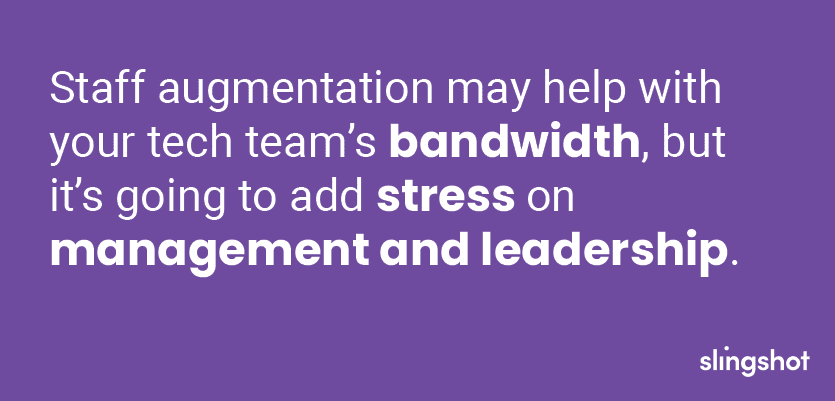Let’s face it – getting things done is harder than ever before. If you used to get pulled in 2 directions, it now feels like you’re getting pulled in 8.
But it doesn’t have to be this way for tech teams; there’s options out there to help take things off your plate. Two of these are Staff Augmentation and Dedicated Teams.
Let’s face it – getting things done is harder than ever before. If you used to get pulled in 2 directions, it now feels like you’re getting pulled in 8.
But it doesn’t have to be this way for tech teams; there’s options out there to help take things off your plate. Two of these are Staff Augmentation and Dedicated Teams.
Which one is right for you? Stick around, and you’ll learn the pros and cons of both dedicated teams and staff augmentation, as well as when it’s best to use them.
Summary
- A Dedicated Team is a full development team, management included, where an external group of developers and designers work together with a client’s internal team to solve the client’s problems through tech.
- Staff Augmentation is when you bring on a singular expert or multiple experts for a short period of time that are directly under your management
- While both can save money, get you access to more talent, and offer flexibility, only a dedicated team can help with collaboration, management, and speed.
- If you have a project with vague requirements, are experiencing managerial bandwidth issues, or are looking for long-term work, a dedicated team is right for you.
- Staff augmentation works best for short-term projects where you have spare management bandwidth inhouse and a fully-defined scope or backlog.
What is it?
Dedicated Team
A Dedicated Team, or outsourced team, is an entire development team with management, analysts, developers, QA, and sometimes designers that you can bring in to assist your current inhouse team.
Dedicated team members work under the management of an external Project Manager or Product Owner to help with strategy, organization, and management. The key focus here is the team: it’s not just one person, but a group of people with a wide variety of skills and experiences.
The dedicated team usually already have experience working together under a proven process, and are often remote, although some have certain members that can come onsite.
Staff Augmentation
When you’re utilizing a staff augmentation (or staff aug for short) approach, you’ll be adding a singular member or multiple members to temporarily augment your current team. While short-term, staff augmentation allows for quick and immediate help. An individual developer or group of developers can get in, fix the issue, and leave your product better than when they got there. Staff Aug personnel are directly under your management so you’ll have to manage their workload, quality, and train them on your process.
Benefits
Since the models have some similarities, there’s going to be an overlap of benefits. Before we dive into why each is special, let’s look at why both options could be a good choice.
Cost Effective Hiring
How much do you spend on hiring? Probably more in recent years, especially for your tech team. Not to add to your stress, but you also have to take into account the salary and benefits of any new full-time hire.

You can skip all that struggle by outsourcing. Whether it’s a dedicated team or a staff aug one, the vendor will handle the monetary cost of bringing on new team members. Budgets go farther when you don’t have to worry about paying salary percentages!
Talent Pool
Back to hiring: it’s harder than ever to find tech talent. We’ve discussed it in our hiring blog: companies are having a difficult time finding developers with the required skill set. And when they do, their salary has grown tremendously over the last few years. By bringing in a separate company, you can have access to a larger talent pool.
Flexibility
Ramping up or ramping down can be such a hassle with an internal team. That’s where outsourcing comes in: either hire a team that has the ability to ramp up and down, or hire a staff aug person to tackle a specific initiative.
Project Specific
If you’re bringing someone in for one goal, they’re more likely to accomplish it. The team or individual you bring in will have a singular purpose: successfully complete this project. There’s no internal distractions or office politics to worry about.
Dedicated Software Team
Now onto what makes a dedicated team stand out.
Cost
Saving money is a good thing, right? With a hybrid onshore/offshore dedicated team, you’ll be spending less money for the same amount of talent. We already mentioned how you’ll skip hiring costs, but you’ll also avoid paying for benefits. In the end, a dedicated team can be as much as 10% less than direct hires, but you get access to a full team with management included!
Collaboration
What sounds easier: a 100 piece puzzle, or a 20 piece puzzle? Fitting individual people into your team can cause more issues than it helps. A dedicated team that already works together is easier to plug into your process than a handful of isolated strangers. By finding a team that already collaborates well, you save yourself time, money, and most importantly unnecessary headaches.

Another side to the collaboration coin is feedback: a dedicated software team can give you advice and offer pushback from their years in development. They’ve seen it all, and you can use that to your advantage. By bringing in an external group, you get access to fresh perspectives and ‘outside the box’ ideas.
Management
This is one of the biggest benefits you can only get from a dedicated team: included oversight. If you utilize staff augmentation, you have two options: hire someone to manage them, or add them to someone else’s already busy plate. That’s not a problem for a dedicated team, as they’ll already have a Project Manager or Product Owner at your disposal. Managerial bandwidth problems, be-gone!
Onboarding Speed
You’ve probably experienced it before: you try to bring in someone to help speed up development, but getting them onboarded takes longer than fixing the issue. A dedicated software team has years of experience not just solving problems like yours, but also working together. This means faster ramp up time, and less time spent onboarding.
Staff Augmentation
We’ve sung the praises of dedicated teams, but it’s time for staff augmentation to take center stage.
Under control
Depends who you ask if this is a blessing or a curse, but staff augmentation doesn’t come with oversight. While this could add to the plate of any management you have, you’ll also have complete control over what that person does. There’s no back-and-forth on what someone should or shouldn’t tackle this week – you’re the driver of this bus!
Skill Specific
Looking for a very specific problem to solve or language to write in? A staff augmentation group can make sure you have someone that has the exact skill you’re looking for. Don’t spend extra money on a full team if you only have one problem: find your expert, have them fix your issue, and move on.
Downsides
We can’t always look on the bright side; if both were perfect, you wouldn’t be reading this article! We’ll need to look at the cons of dedicated teams and staff augmentation.
Dedicated Software Team
Short term projects
It doesn’t make sense to bring in the cavalry when you have a ‘small’ problem to fix. Dedicated teams work best when you have lots of work that needs to be done. Don’t overspend on a dedicated team when a singular person could get it done faster and at a lower cost.
Finding a team
Since you’ll be working closely with a dedicated team for a while, it’s important to find the right group. This means you’ll have to spend more time up front ensuring there’s a business and culture fit. What if y’all have different processes? Priorities? You either have to spend resources upfront to find the right group, or risk the project being unsuccessful with the wrong one.
Pushback
Sometimes you know what you want, and that’s great! But when you have an entire team that disagrees with your decision, it could cause more roadblocks than you’re looking for. If you have a specific set of requirements you don’t want to stray from, go with a different model.
Staff Augmentation
Onboarding
Getting brought up to speed is something that will happen with any project; no one can jump in and get started instantly. But with staff augmentation, your onboarding will take just as long as a full time hire. Sure, a dedicated team will need to be brought up to speed as well, but they’re acting as a separate entity. A staff aug person will need to know the ins and outs of the internal policies to be successful.
Long Term cost
Staff augmentation can save you money on hiring, but you’ll probably end up spending more in the long-run. When compared to a direct hire long term, an individual brought on as staff augmentation can be between 25% and 35% higher. If you can’t find the team you need, staff augmentation can help, but it’ll cost you.
Managerial burden
We’ve already mentioned it, but this is a big one: staff aug may help your tech team’s bandwidth, but it’s going to add stress on management. If management or your c-suite is stretched too thin as it is, it’s probably not a good idea to try and have them manage additional personnel.

When to use
So both have their pros and cons, but which one is the right fit for you? If you still can’t decide, here’s a look at when it’s best to use a dedicated team vs staff augmentation.
Short-Term Projects. You can probably guess from what we’ve already said, but a staff aug person is great for when you need something done quickly. Don’t spend the same amount of time finding a partner that you would spend building; have someone come in quickly to help.
Scope Assistance. Maybe you know you have a problem or piece of tech you want to build, but you want help finalizing the specifics. A dedicated team can work with you to nail down the scope, which takes pressure off your entire team.
Smaller Budget. Let’s face it: sometimes you may not have all the resources you need to get a project done. But you also know that the issue needs to get taken care of ASAP. Call in staff aug, as you can get access to an expert quickly.
Expansive Projects. Since staff aug is great for the short-term, it makes sense that a dedicated team is best for long-term work. You’ll get more bang for your buck in the long run if you go with a full team.
Defined Requirements. One last time: if you know exactly what you want, go with staff augmentation
Conclusion
A dedicated team is perfect for a project with vague requirements, a team experiencing managerial bandwidth issues, or a company looking for long-term work. If you have a short-term project, limited time and budget, or a fully-defined scope, go with staff augmentation.
Hopefully you can now see the light at the end of the tunnel, and know that there’s ways to take stress off yourself and the rest of your team. Now the question is, what are you going to do with the extra free time? ?




